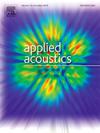Practical spatial acoustic measurements in performance halls with a reduced virtual orchestra
IF 3.4
2区 物理与天体物理
Q1 ACOUSTICS
引用次数: 0
Abstract
The Virtual Orchestra has previously been used to measure room acoustic conditions of major concert halls, with the aims of objective comparisons and subjective evaluations through auralization, and to characterize and investigate specific problems in halls.
The idea is to simulate an actual orchestra on stage with an array of loudspeakers and then measure the spatial impulse response in the hall with multiple source positions. This approach gives a more complete picture of the acoustic projection and reflection paths between the stage and the audience than traditional measurements with a single omnidirectional loudspeaker in few positions.
However, the originally proposed system requires over 24 loudspeakers and is therefore not very convenient for consultants to use from the practical perspective.
In this paper a scaled-down version of the measurement system is presented. This system uses a total of 8 loudspeakers and the spatial impulse response is recorded by a standard A-format microphone. The comparison to the original system is presented with spatial analysis results, and the study is accompanied by examples of results and findings achieved with practical measurements in halls.
实际空间声学测量在演出大厅与减少虚拟乐团
此前,虚拟管弦乐团已被用于测量主要音乐厅的室内声学状况,目的是通过听觉化进行客观比较和主观评价,并表征和调查大厅中的具体问题。这个想法是用一组扬声器在舞台上模拟一个实际的管弦乐队,然后用多个声源位置测量大厅里的空间脉冲响应。这种方法提供了舞台和观众之间的声学投影和反射路径的更完整的图像,而不是传统的在几个位置使用单个全向扬声器的测量。但是,最初提议的系统需要24个以上的扬声器,因此从实际角度来看,顾问使用起来不是很方便。本文给出了该测量系统的缩小版。该系统共使用8个扬声器,空间脉冲响应由标准a格式麦克风记录。本文给出了与原系统的空间分析结果的比较,并附有在大厅实际测量中取得的结果和发现的例子。
本文章由计算机程序翻译,如有差异,请以英文原文为准。
求助全文
约1分钟内获得全文
求助全文
来源期刊

Applied Acoustics
物理-声学
CiteScore
7.40
自引率
11.80%
发文量
618
审稿时长
7.5 months
期刊介绍:
Since its launch in 1968, Applied Acoustics has been publishing high quality research papers providing state-of-the-art coverage of research findings for engineers and scientists involved in applications of acoustics in the widest sense.
Applied Acoustics looks not only at recent developments in the understanding of acoustics but also at ways of exploiting that understanding. The Journal aims to encourage the exchange of practical experience through publication and in so doing creates a fund of technological information that can be used for solving related problems. The presentation of information in graphical or tabular form is especially encouraged. If a report of a mathematical development is a necessary part of a paper it is important to ensure that it is there only as an integral part of a practical solution to a problem and is supported by data. Applied Acoustics encourages the exchange of practical experience in the following ways: • Complete Papers • Short Technical Notes • Review Articles; and thereby provides a wealth of technological information that can be used to solve related problems.
Manuscripts that address all fields of applications of acoustics ranging from medicine and NDT to the environment and buildings are welcome.
 求助内容:
求助内容: 应助结果提醒方式:
应助结果提醒方式:


